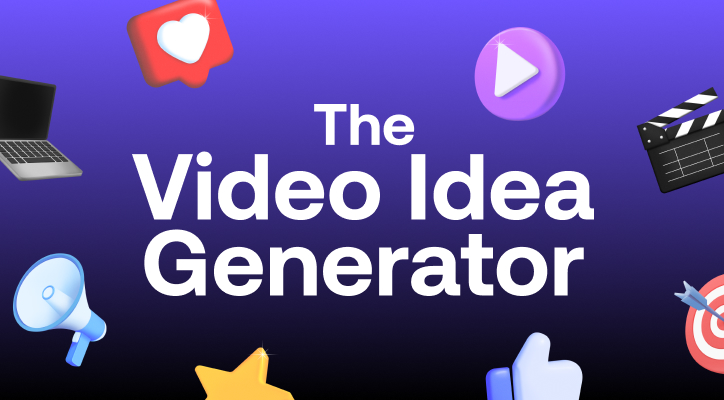Branded content video is a great opportunity to increase awareness while simultaneously building a strong brand perception.
In this comprehensive guide, you’ll learn how to build a solid strategy that’ll engage your viewers and increase branded recognition.
Read on to find out more about branded posts, and why it’s vital for any business’s success!
What is brand content?
In a nutshell, this refers to content that is created by a brand to improve its image, generate engagement and increase company awareness.
It also offers many advantages in terms of marketing a company and its products, such as:
- Shaping a company’s brand image and brand voice, both digitally and offline.
- Generating customer engagement: A 2018 study from Sprout has revealed that 66% of consumers say it’s important for brands to take public stands on current topics and issues.
- Helping consumers relate to the company by showcasing its core values and the issues it cares about.
- Fostering customer loyalty and turning clients into ambassadors—this is a key argument as platform users have been gaining power over companies and their marketing results.

Have you thought of creating a brand book?
We advise you to create a brand book that’ll allow collaborators to respect all the brand guidelines for your content.
The difference between brand content and content marketing
Understanding the difference between brand content and content marketing is essential if you are planning on developing brand content. Thankfully, the difference is pretty easy to understand:
- The main focus of brand content is developing a corporate image. Its messaging focuses on the brands themselves and this includes its values, the way it takes a stance on social and political issues and its commitment towards its audience.
- A content marketing strategy focuses on generating conversions. It emphasizes brands’ expertise and the quality of their products or services—the end goal being convincing its target audience to make a purchase.
An easy way to understand this distinction is remembering that brand content is brand-centric while content marketing is customer-centric.
This also means you don’t necessarily need to choose between both marketing techniques as they aim to achieve different things. In fact, an ideal online communication plan should make the most of these two ways to promote your brands.
The most successful types of brand content
You might be wondering what kind of content your editorial plan should include.
Here are some examples:
- Blog articles—whether they are hosted on your own website or other digital media platforms—could help you spread information on some of the recent steps your brand has taken, such as a donation to a non-profit or a new position on a social issue.
- White papers or e-books are usually connected to your own industry and its latest developments. Their main benefit is to demonstrate your expertise in a more subtle way.
- Infographics are a very popular format that let you share key data or trends related to your sector in a visual way—without directly promoting your own product or service.
- Podcasts are one of the hottest trends in terms of brand content. They are ideal to become an influencer within your field and to reach your public more easily.
You could also choose to involve your target audience more directly with efficient and interactive formats:
- IRL gatherings like conferences or TEDx events, or virtual events (webinars, online conferences…) will let you spread a specific message in a memorable way.
- Giveaways (which can be hosted on media platforms) could also be relevant — as long as they don’t directly involve your own offers or products.
To us however, the key format has to be video! That’s because it makes storytelling easy, is memorable by nature and can easily be shared on media platforms.
It has been shown that individuals retain 95% of a message when they watch it on video, compared to just 10% when reading it in a text. Have you thought about creating an explainer video? It's a very popular and appreciated format.
A lot of options are available when it comes to the type you want to produce. Here are some examples:
- Short films are a way to introduce your key values and the social issues your brand stands for with your brand launch story for example. Remember Hair Love, Dove’s Oscar-nominated animated short film? Talk about something memorable!
- Posts featuring or addressing your target audience, such as Always’ #LikeAGirl campaign, do a great job when it comes to sharing a message in an authentic and impactful way.
- Social platform ads are short and eye-catching, which is great to spread a message linked to your own brand within just a few seconds. You can even create an AI Avatar to humanize your video and deliver your message!
- Posts geared toward social media, such as the ones made by trailblazing French company Brut. —which entered the US market in early 2020— are an effective option to deliver strong ideas without focusing on your product or service while doing so.
- Sponsored brand ads or posts offer a strategic approach to showcase your brand's message through targeted advertising campaigns. For example, it can be like an Amazon sponsored brand video.
Now that your mind is racing with ideas, it’s time to create your brand introduction video!
6 ways to create engaging brand content
Here is a list of the 6 best practices to follow:
1. Focus on your brand—not on your product
This might seem like common sense, but some marketers or comms professionals often find it hard to dissociate their brands from the product or service it offers.
Other topics you could cover or focus on include:
- Your organization’s values. If your business is actively involved in advertising specific social issues such as gender equality or the fight against climate change, you could reaffirm your position by producing content that communicates your stance or tries to rally people around this issue. Brand activism is a hot topic after all.
- Your history. You can focus on advertising the way your brand was created or its expansion to have a relevant storyline. Just make sure your advertising stays as impactful or engaging as possible.
- Your culture. The recent COVID-19 pandemic has revealed just how much customers care about the way companies treat their employees: a study by Morning Consult has shown that a whopping 49% of consumers consider whether or not companies take care of their employees as one of their top 5 purchasing considerations. Your brand content could highlight how your business keeps its employees happy and showcase actions you’ve taken towards a better work-life balance or mental health at work.
- Your brand’s mission statement. Etsy aims to "keep commerce human", Nike wants "to bring inspiration and innovation to every athlete in the world" and TED "spreads ideas." Why not dedicate your brand content to the ways your company wants to change or shape the world?
Not focusing on what your business sells might seem awkward at first , but a couple of brainstorming sessions will surely reveal the story your brand should tell. Check out how these 13 companies chose to tell their story through these best brand videos examples.
2. Storytelling is your friend!
Remember that your target audiences will be (re)discovering your brand through the stories you tell them.
Optimize the quality of your storytelling by:
- Personifying your public. This requires a deep understanding of your target audience and being able to represent them with characters that won’t seem too cliché.
- Triggering emotional responses. Whether it’s joy, melancholy or serenity, you should aim straight for the heart when addressing your audience as this’ll make your content much more memorable. Some experts actually think that “emotional branding” is the future, so keep that in mind.
- Keeping your content entertaining. Whether you’re producing a short article that details your latest CSR initiative or making a corporate video, remember that what you’re producing should never bore your audience. Tell your story in an exciting but structured way—include plot twists or a surprising ending. Discover our articles on corporate training video and what is csr.
- Speaking the same language as your target audience. Your brand’s tone of voice is an essential aspect when it comes to creating powerful content. Avoid technical terms and always use short and direct sentences. Have each piece of your brand speak your language, from the engaging logo design to the compelling slogan.
Developing strong storytelling skills takes time, but it is the key to turning your content into a story!
3. Always think long-term
Crafting and releasing content should never be a one-off exercise and your strategy should take this into account. Remember that building your brand’s image is a process.
We recommend working on an editorial calendar for your content, mixing evergreen content with more seasonal topics throughout the year—all while making sure the themes you address are relevant to the story you want to tell.
If you’re looking for an example of powerful seasonal brand content, just take a look at German supermarket corporation Edeka’s Christmas campaign from a few years ago. We’re not crying, you’re crying!
4. Think campaigns
Here are some of the benefits think campaigns have to offer:
- Campaigns allow for 360 degree communication. The impact of your campaigns will be stronger if it is supported by a hashtag, related branding for print content, a dedicated landing page on your website etc.
- Campaigns make it easier to evaluate the performance of your brand content. Allocating a specific timeframe to each campaign will allow you to track its results in a more precise way.
5. The power of multichannel content distribution
Think of distributing your content on the platforms where your target viewers are present. However, nowadays, internet users tend to hop between platforms when consuming content. This means you need to share content in multiple places.
Keep that in mind when creating your content—the places where it’ll be posted dictate the way it should look and what type of content it’ll be. As you probably know, each network has got its own requirements in terms of specs and sizes.
You’ll make your life much easier by having multichannel distribution in mind from the very beginning of your creation process. From your YouTube channel to your social platforms, make sure your public doesn’t miss out.
6. Follow a modular content strategy
This method is an efficient way of generating many pieces of content at once, which can be tailored for individual use cases, audiences, and channels.
Need an example? Let’s say you’ve written a great blog post about 5 measures your business is taking to improve its sustainability. Following the modular method means you will immediately be able to turn this article into a striking infographic and a ‘snackable’ top 5 video.
Modular content creation should be on your mind as soon as you start working on an editorial calendar as this’ll help you spread your key messages simultaneously on every platform and without overspending on content creation.

Have you thought about making a presentation for your next piece of content?
4 best metrics to evaluate your performance
As you know by now, brand content has a direct influence on your image. This means measuring its impact can be trickier than with content marketing, as the latter aims to convert rather than entertain.
But of course, there are ways to estimate the ROI of brand content: just focus on KPIs that measure engagement and brand affinity.
Here are the 4 metrics you should be looking at:
- Purchase intention among members of your target public that have been exposed to your campaign. You could measure that by running a simple survey among your current prospects and customers. Just ask them whether they’ve seen your content and whether they are considering a purchase in the near future.
- Brand preference—here too, a survey would be the way to go to gather data.
- Platform engagement—just check how well network posts have been performing in terms of likes, comments or shares.
- Backlinks—a successful brand campaign should make people talk about it online, which is also beneficial for your SEO.
Keeping an eye on the numbers will help you identify your own best practices. After all, a successful brand strategy implies constant improvements to find ways to increase your public’s engagement and loyalty.
Create professionally branded videos with PlayPlay
PlayPlay is an example of a video creation software that makes it easy for anyone to create high-quality, branded professional videos in a fraction of the time and cost that production agencies typically require.
You can benefit from PlayPlay’s specific branding functionality that lets any creator on the platform include branded elements to embellish their videos. You can customize your branded product ads using your logo, colors, and other visual elements to aid brand recognition.
Ready to get started? Try PlayPlay free for 7 days.
Branded content ads are a technique that is usually developed through a sponsored or paid collaboration between a brand and a media outlet. These branded ads are designed to engage your public by offering branded entertainment, information, or educational value.
Yes, you can get paid for sharing branded content on Instagram! If you’re an influencer showcasing branded products or services on the social media platform, companies will most likely be paying you to advertise their branded offerings for them. If you’re a business showing off your branded products and services, audience members will see them and be more likely to purchase from you - which eventually leads to you getting paid.


